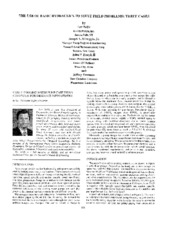| dc.contributor.other | International Pump Users Symposium (13th : 1996) | |
| dc.creator | Nelik, Lev | |
| dc.creator | Silvaggio, Joseph A. | |
| dc.creator | Joseph, John P | |
| dc.creator | Freeman, Jeffery | |
| dc.date.accessioned | 2017-10-05T17:00:40Z | |
| dc.date.available | 2017-10-05T17:00:40Z | |
| dc.date.issued | 1996 | |
| dc.identifier.uri | https://hdl.handle.net/1969.1/164159 | |
| dc.description | Tutorial | en |
| dc.description | pg. 175 | en |
| dc.description.abstract | Single stage double suction horizontally split pumps are widely used in cooling tower water applications. Their operational record varies depending on installation (sump and piping detail), mode of operation, speed, specific and suction specific speed, metallurgy, and other parameters. Pump noise and cavitation damage are the most frequently uncounted problems with these types of pumps. Even though much has been published on pump cavitation, the upstream conditions of the cooling water pumps are such that many of the classical cavitation remedies are difficult to apply. Obviously, a pump design that would allow a wider operating flow region would significantly ease the restriction on the user, and be economically attractive. The case presented in this tutorial is an example of a joint effort between the pump manufacturer and a user to come up with the design solution, which would optimize the above mentioned requirements, reduce noise and cavitation damage, and improve overall reliability of these pumps. | en |
| dc.format.medium | Electronic | en |
| dc.format.mimetype | application/pdf | |
| dc.language.iso | en | |
| dc.publisher | Texas A&M University. Turbomachinery Laboratories | |
| dc.relation.ispartof | Proceedings of the 13th International Pump Users Symposium | en |
| dc.subject.lcsh | Pumping machinery | en |
| dc.title | The Use Of Basic Hydraulics To Solve Field Problems: Three Cases | en |
| dc.title.alternative | Use Of Basic Hydraulics To Solve Field Problems: Three Cases | en |
| dc.type.genre | Presentation | en |
| dc.type.material | Text | en |
| dc.identifier.doi | https://doi.org/10.21423/R1HX20 | |


